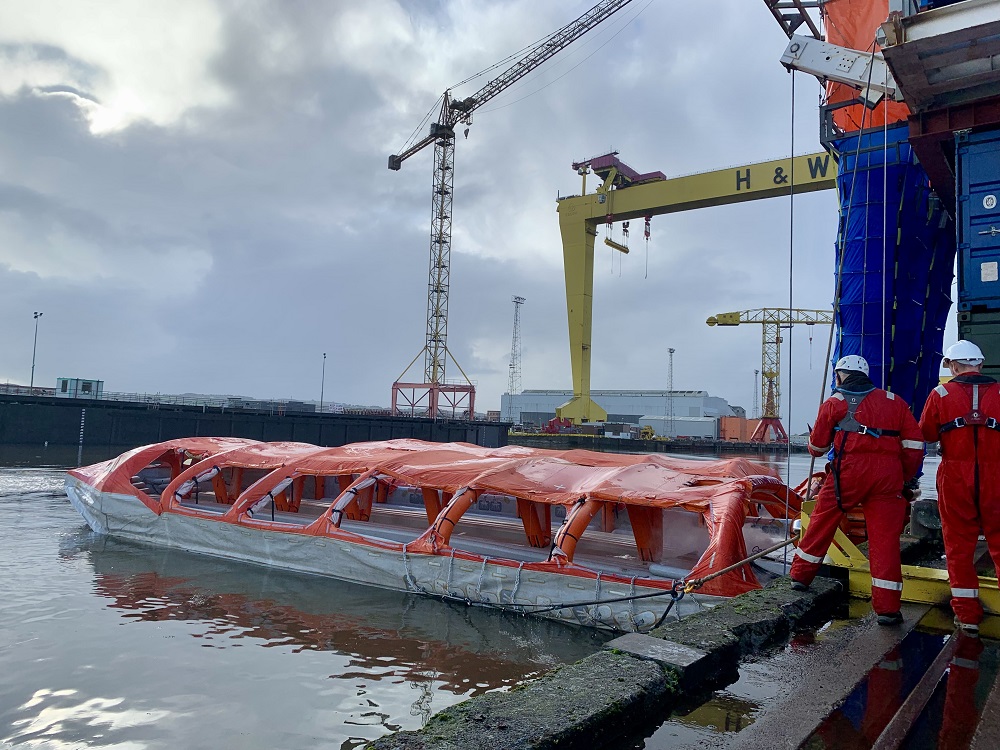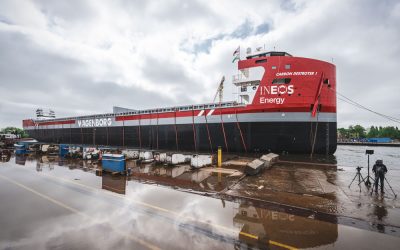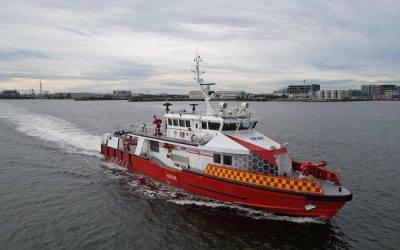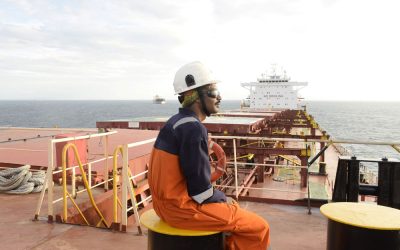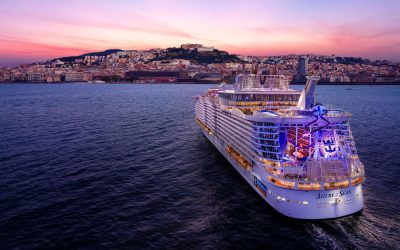The sinking of the Titanic was a tragedy that shook the world. The widespread outrage over the disaster led to sweeping changes on the requirements of lifeboats on board a vessel and the establishment in 1914 of the International Convention for the Safety of Life at Sea (SOLAS) which still governs maritime safety today. It was perhaps fitting, then, that TNA was invited late last year to the Port of Belfast – home of the famous Harland & Wolff shipyard and the very place where the ill-fated luxury liner was designed, built and launched – for a demonstration deployment of a new safety innovation that promises to redefine evacuation at sea.
Seahaven, developed by UK-headquartered survival technology company Survitec, is said to be the world’s largest inflatable lifeboat. The self-propelled craft has been designed to replace the established rigid-hull lifeboats found on cruise ships and, according to Survitec, solves the challenge of being able to evacuate an increasing number of cruise passengers quickly and safely, while freeing up additional existing lifeboat deck space for greater passenger experiences.
Speaking at the demonstration, Stew Gregory, Survitec’s head of manufacturing transformation, tells TNA: “Based on years of research and successful trials, we expect Seahaven to not only revolutionise the way in which passengers evacuate in an emergency but also how cruise ships are designed.”
The two-craft, 1,060-capacity system is stored in a container with a footprint of 16.3m x 3.6m that fits onto a single deck. A single-release button – either on the bridge or locally at the station where the lifeboats are stored – unrolls, lowers and inflates each lifeboat in under four minutes, eliminating the complexities associated with the traditional davit and release-hook system. Seahaven is served by multiple helical slides, a solution pioneered and evolved by Survitec for more than 20 years.
Once deployed the 27m-long, 9m-wide lifeboats can sail independently, powered by SOLAS approved twin diesel outboards, at 6knots for 24hours.
Years in the making
Survitec’s roots trace back over 160 years, with Gregory having worked on some of the most game-changing and successful projects in the company’s recent history. He explains that Seahaven has been more than six years in the making and is borne from the collaboration of Survitec’s aerospace, defence and maritime survival technology expertise.
“The technologies that we’ve used are slightly different to our normal liferaft technologies,” he notes. “For example, we’re using higher pressure so have gone for a drop-stitch technology similar to that used in inflatable SUPs (stand up paddleboards). This results in a much more rigid and water efficient structure.
“And because of the amount of gas and inflation we’ve got in there, we’ve also had to develop our own inflation system and composite cylinders. So there’s lots of new and firsts for Survitec and the industry.”
The helical slide system has been adapted from Survitec’s Marin Ark marine evacuation system (MES) and for those attending the demonstration – a mix of representatives from cruise operators, yards, Class and Flag – there’s an opportunity disembark down it once Seahaven has been deployed. The system integrates the benefits of a fully enclosed evacuation chute with the natural descent of a spiral slide and is easy to navigate, with evacuees able to control their rate of travel as they descend.
The slides have been proven to allow quick evacuation for both able bodied and mobility impaired persons, of all ages and sizes, and also permits family groups to descend together, reducing stress during the evacuation process, according to Robert Kledal, Survitec’s chief executive officer. “Seahaven is reliable and more importantly safer than current evacuation arrangements,” he adds.
Approved and ready to go
Seahaven was awarded type approval by classification society Lloyd’s Register in September 2022. This followed on the heels of the successful completion of heavy weather sea trials (HWST), carried out in line with the SOLAS requirements for Novel Appliances which require the test to be performed in conditions that do not drop below six on the Beaufort Scale, and the International Maritime Organization (IMO) A.520 physical tests as required by Lloyd’s Register. An evacuation time of under 22 minutes was achieved during the A.520 tests.
“It’s now ready to be installed on cruise vessels and we’re getting very close to the first installation,” Kledal tells TNA, highlighting current plans to have the system as the primary means of evacuation on board an upcoming newbuild and ongoing talks with a number of other cruise operators about future applications.
The operators see numerous benefits in installing Seahaven on board their vessels, he says, not least its innovative space saving design. Typically, notes Kledal, a 4,000-passenger capacity cruise ship would require at least 12 to 16 lifeboats and up to two MES with liferafts. Just four Seahavens would be required to evacuate the same number of passengers. Research undertaken by Survitec shows that replacing conventional lifeboats with Seahaven can free up to an additional 85% of existing lifeboat deck space, yielding up to around US$8 million in increased revenue per year for cruise operators.
The system not only redefines safety at sea but also takes cruise ship design to another level, says Kledal, adding that operators and cruise ship designers are already looking at remodelling the space normally given to conventional lifeboats and davits for additional cabins, public spaces and revenue generating opportunities. The challenge of finding extra storage capacity for the new generation of lower carbon fuels on the horizon may also be in their thinking.
“We believe the cruise industry is ready for an alternative, safer solution to the traditional lifeboat/davit arrangement and based on increased enquiries we anticipate a significant number of Seahaven-equipped ships to enter service within the next decade,” concludes Kledal.
More than one hundred years on from the Titanic, it would appear that Survitec’s inflatable proposition is making a compelling case for another major evolution in passenger ship safety.
